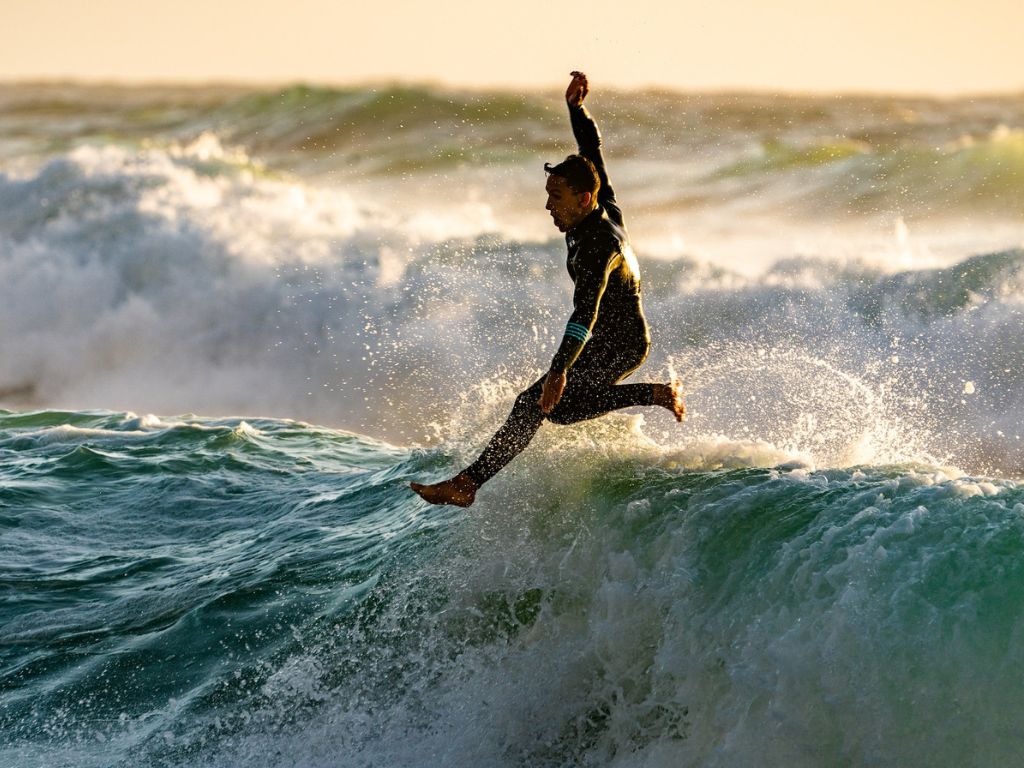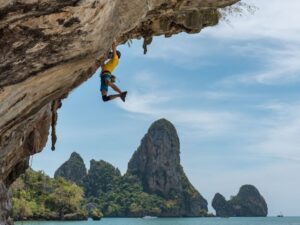I’ve embraced the thrill of facing challenging surf spots for over two decades. And yes, that means being able to visit some of the most dangerous and hardest spots worldwide. Were all of my attempts successful? Hell no!
I’m not a pro by a long shot. But I made some amazing memories that you must experience for yourself.
Whether you’re a seasoned surfer seeking new horizons or a curious soul planning your next adventure, this article is for you. Not to be too Discovery Channel-ish, but we’re gonna be exploring the world of untamed surf breaks that give a worthy fight to even pro surfers.
Before I give you my list, let me tell you a bit about the criteria for making a surf spot challenging or dangerous. Of course, you can skip ahead if you’re not into technicalities.
Some spots are not for the faint of heart when it comes to surfing. They demand more than just skill as they challenge every ounce of determination and resilience within you.
Five factors make a wave quite challenging:
- The sheer power of the waves that are not meant for your average rollers,
- notorious unpredictability leaving surfers to adapt on the fly,
- presence of perilous terrains like jagged rocks, reef breaks, and shallow sandbanks,
- dangerous weather conditions such as strong winds, heavy rains, or thick fog;
- and finally, the crowd around you makes a huge difference.
In a nutshell, challenging surf spots push surfers to their limits, physically and mentally. At the expense of sounding too poetic – it’s a realm where adrenaline meets humility, and triumphs go hand in hand with wipeouts.
1. Nazare, Portugal
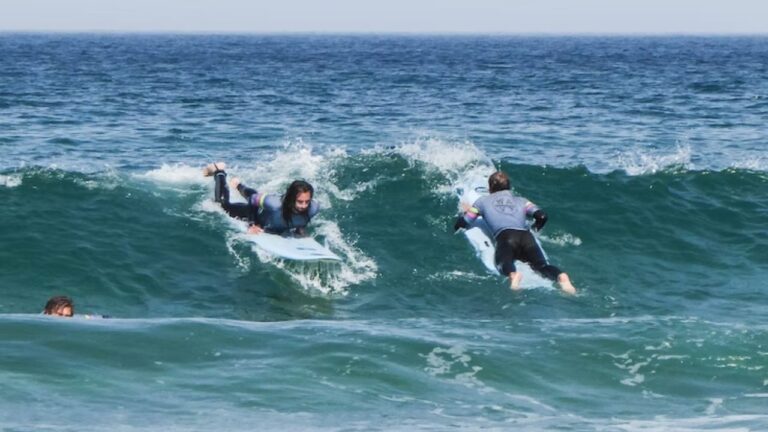
| Best Time of the Year | October to April |
| Average Height of Waves | 50ft (average), 80ft (rare) |
| Type of Break | Beach Break |
| Other Difficult Surf Spots | The Cave, Supertubos, Peniche |
| Other Activities | Cliff Diving, Windsurfing |
Nazare (Portugal) is one of the hardest places to surf in the world, alongside Pipeline (Hawaii) and Mavericks (California). The unique underwater Nazare Canyon amplifies the swell and creates up to 80 feet-high waves. This has earned Nazare the title of the “Big Wave Capital of Europe.”
Surfing here is not for the faint-hearted. These waves’ immense power and force demand incredible skill, courage, and experience. But its allure doesn’t stop at surfing.
The coastal cliffs and rugged landscape offer excellent opportunities for other extreme adventure sports, such as cliff diving and windsurfing.
If your sole purpose is to check out difficult spots, you should hit “The Cave” after Nazare, located in the coastal town of Ericeira, Portugal.
| Average Flight Cost (from the US) | $500 – $1000 |
| Average Accommodation Cost | $50 – $200 per night |
2. Pipeline, Hawaii
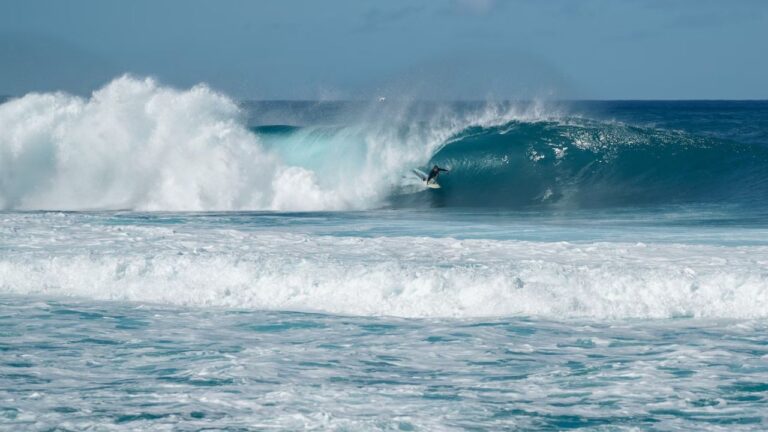
| Best Time of the Year | November to February |
| Average Height of Waves | 9ft (average), upto 20ft |
| Type of Break | Reef Break |
| Other Difficult Surf Spots | Jaws (Maui), Waimea Bay (Oahu) |
| Other Activities | Cliff Jumping, Stand-Up Paddleboarding |
Pipeline, located on Oahu’s North Shore, is the iconic jewel of Hawaii’s surf scene. Renowned for its pristine barrels and powerful waves, it is one of the planet’s most challenging and revered surf spots.
Its hollow waves that create perfect, cylindrical barrels set Pipeline apart. The waves break over a shallow, razor-sharp reef, which can quickly become deadly if you aren’t too careful.
With waves reaching up to 20 feet in height, it’s not just the power but the precision required to navigate these tubes that make it a formidable surf spot.
I’ll always remember my first encounter with Pipeline. The amazement when I committed to the drop was short-lived as the wave closed in a heartbeat, wiping me out.
Jaws, called Pe’ahi on Maui, is a mecca for big-wave surfers. The sheer size and power of Jaws’ waves are awe-inspiring.
Likewise, Waimea Bay on Oahu is a legendary big wave spot known for its annual Eddie Aikau Invitational surf competition.
| Average Flight Cost (from the US) | $100 – $450 |
| Average Accommodation Cost | $150 – $400 per night |
3. Mavericks, California (USA)
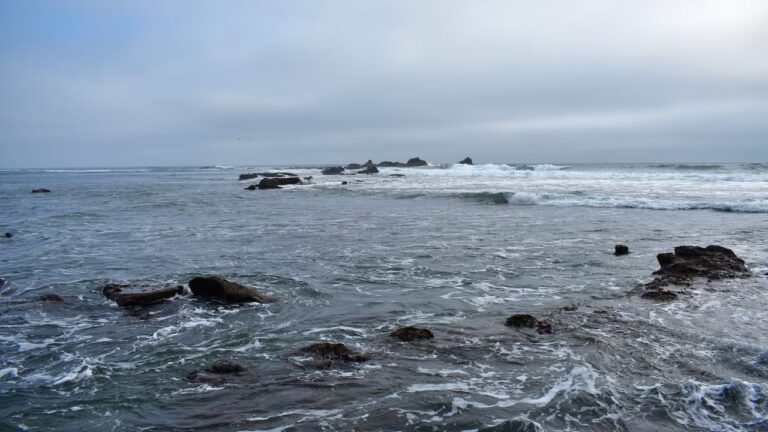
| Best Time of the Year | October to March |
| Average Height of Waves | 25ft (average), upto 60ft |
| Type of Break | Reef Break |
| Other Difficult Surf Spots | The Wedge (Newport Beach) |
| Other Activities | Rock Climbing, Skydiving |
Nestled off the coast of Half Moon Bay, Mavericks stands as a legendary big wave surf spot known for its colossal and awe-inspiring waves. As I said, it’s the holy trinity of the hardest places to surf alongside Pipeline and Nazare.
Every year, during the peak season, the Pacific Ocean churns up swells that can reach towering heights of up to 60 feet. The unique underwater rock formations and the abrupt drop in the ocean floor make them even more challenging.
The wave’s power, combined with the frigid waters and jagged reef below, make it an exceptionally challenging and dangerous spot for surfers. Successfully navigating these enormous waves demands exceptional surfing skills that only some possess.
California’s coastline is dotted with various other difficult surf locations. And one notable contender is The Wedge in Newport Beach, known for its powerful shore break.
| Average Flight Cost (Interstate) | $100 – $250 |
| Average Accommodation Cost | $100 – $300 per night |
4. Shipsterns, Australia
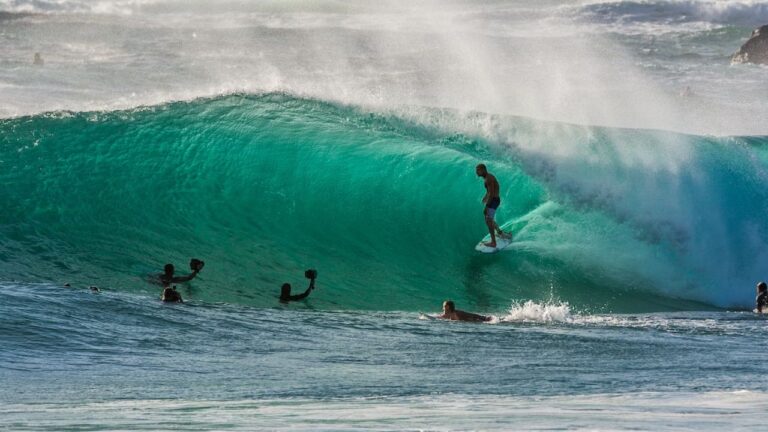
| Best Time of the Year | March to October |
| Average Height of Waves | 20ft to 30ft |
| Type of Break | Reef Break |
| Other Difficult Surf Spots | The Box, Cyclops, Ours |
| Other Activities | Skydiving, Bungee Jumping |
Shipsterns Bluff is a remote big wave surf spot infamous for its intense swell and razor-sharp rocky reef. These swells converge with the shallow reef, creating massive, hollow waves challenging even the most seasoned big-wave surfers.
What makes Shipsterns so daunting is its sheer power and ferocity. The waves break with incredible force, causing you to race down the face of the wave before navigating the treacherous barrel section.
Even a single mistimed maneuver can lead to a dangerous wipeout, where the surfer faces being hammered into the reef below.
Australia also boasts several other challenging surf spots, including The Box, Cyclops, and “Ours.”
| Average Flight Cost (from the US) | $800 – $1500 |
| Average Accommodation Cost | $100 – $300 per night |
5. Teahupoo, Tahiti

| Best Time of the Year | April to September |
| Average Height of Waves | Up to 25 feet |
| Type of Break | Reef Break |
| Other Difficult Surf Spots | Taapuna, Papara |
| Other Activities | Surf Kiteboarding, Jet Skiing |
Aptly named by locals as the “End of the Road,” Teahupoo is a world-renowned surf spot and an undisputed giant in big wave surfing.
The reef break here is infamous for its heavy, thick-lipped waves that break close to the jagged coral below. When the swell lines converge with the shallow reef, it creates incredibly hollow barrels with waves reaching up to 25 feet or more.
To surf here, you must navigate critical takeoffs, endure brutal wipeouts, and thread the needle through impossibly tight barrels. One slight mistake could lead to disastrous consequences, making each ride a dance with danger.
Beyond Teahupoo, Tahiti offers other formidable surf spots, including Taapuna, known for its powerful and hollow waves, and Papara, with its fast and challenging reef breaks.
| Average Flight Cost (from the US) | $1000 – $2000 |
| Average Accommodation Cost | $200 – $600 per night |
6. Belharra, France

| Best Time of the Year | October to March |
| Average Height of Waves | Up to 60 feet |
| Type of Break | Reef Break |
| Other Difficult Surf Spots | Hossegor, La Graviere |
| Other Activities | Paragliding, Rock Climbing |
Belharra, located in the Bay of Biscay off the southwestern coast of France, is an Atlantic beast that hardly ever ends up on most bucket lists.
Riding the waves at Belharra requires a perfect storm of conditions. The spot lies far offshore, so you must navigate through strong currents and unpredictable winds to reach the colossal waves breaking over a shallow and jagged reef.
The waves here offer a short window of opportunity, making it a demanding and often unpredictable surf spot. As a result, only a select few elite surfers dare to tackle this legendary spot.
France, known for its rich surfing culture, is home to other challenging surf spots. Hossegor, with its notorious beach breaks, and La Graviere, offering powerful and hollow waves, are among the country’s surf gems that attract surfers seeking world-class waves.
| Average Flight Cost (from the US) | $600 – $1500 |
| Average Accommodation Cost | $100 – $300 per night |
7. Dungeons, South Africa
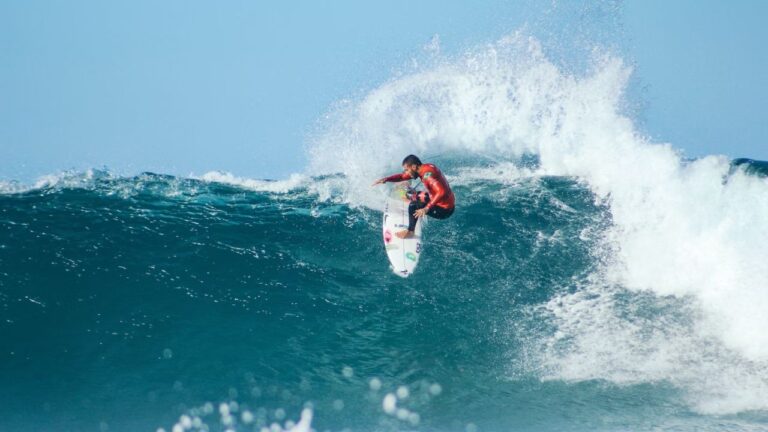
| Best Time of the Year | May to September |
| Average Height of Waves | Up to 30 feet |
| Type of Break | Reef Break |
| Other Difficult Surf Spots | Jeffreys Bay, Cape Town |
| Other Activities | Shark Cage Diving, Bungee Jumping |
Dungeons’ waves are notorious for their incredible power and challenging conditions. On top of that, this surf spot sits far offshore, accessible only by boat. So you’ll have to go through shark-infested waters to reach the break in the first place.
If you want proof of their reputation, Dungeons hosts the annual Big Waves Contest. This prestigious competition attracts big wave surfers from around the globe, eager to test their mettle against the mighty wave.
South Africa also has other world-class surf spots like Jeffreys Bay, known for its perfect waves and incredible barrels.
| Average Flight Cost (from the US) | $800 – $1500 |
| Average Accommodation Cost | $50 – $200 per night |
8. El Gringo, Chile
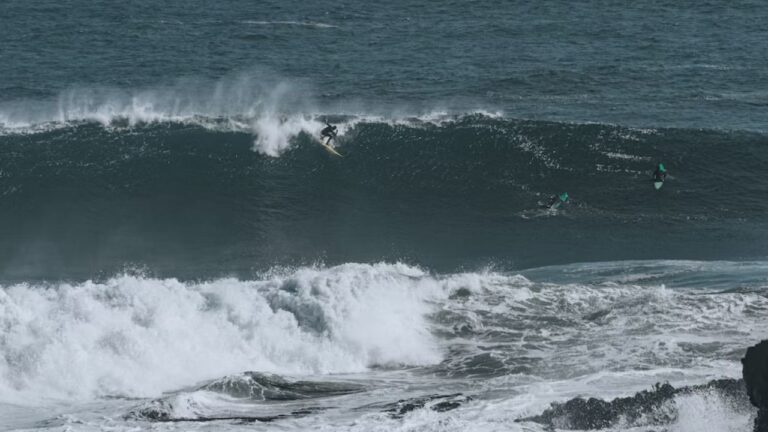
| Best Time of the Year | April to October |
| Average Height of Waves | Up to 15 feet |
| Type of Break | Reef Break |
| Other Difficult Surf Spots | Punta de Lobos, Pichilemu |
| Other Activities | Whitewater Rafting, Mountaineering |
El Gringo, situated in the coastal town of Arica, Chile, is a relentless and powerful reef break known as the “Chilean Pipeline.”
As with others, the wave breaks over a shallow reef, creating steep and hollow barrels that demand perfect timing and positioning to navigate safely.
The challenging conditions and the wave’s powerful, bone-crushing force have earned El Gringo respect and notoriety among big wave enthusiasts. So much so that you’ll often see surfers putting on helmets who would rather avoid them.
With its iconic left-hand point break, Punta de Lobos and Pichilemu, known for their consistent and powerful waves, are among the country’s surf gems that attract thrill-seeking surfers.
| Average Flight Cost (from the US) | $600 – $1200 |
| Average Accommodation Cost | $50 – $150 per night |
9. One Palm Point, Indonesia

| Best Time of the Year | April to October |
| Average Height of Waves | Up to 12 feet |
| Type of Break | Reef Break |
| Other Difficult Surf Spots | Desert Point, G-Land |
| Other Activities | Volcano Trekking, White Water Rafting |
If the use of helmets worried you at the Chilean Pipeline, wait till you hear about One Palm Point in Indonesia. Surfers are often seen with full-on helmets and customized body-armor suits to prevent being crushed by the wave here.
One Palm Point presents a formidable challenge for surfers. The wave breaks over a shallow coral reef, creating powerful barrels. The spot’s remoteness adds an element of adventure and a sense of discovery to the surfing experience.
Each session is a cherished opportunity to ride pristine waves in a secluded paradise because only a few surfers can access the spot.
Indonesia also hosts another dangerous world-class spot – Desert Point, located on Lombok Island. Although you should be more wary of Malaria than waves when surfing at Desert Point.
| Average Flight Cost (from the US) | $800 – $1500 |
| Average Accommodation Cost | $50 – $200 per night |
10. Agiti, Spain
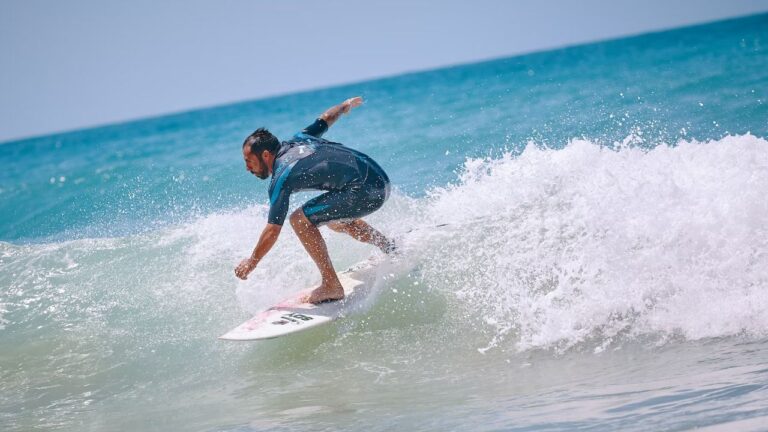
| Best Time of the Year | September to March |
| Average Height of Waves | Up to 20 feet |
| Type of Break | Reef Break |
| Other Difficult Surf Spots | Mundaka, El Quemao |
| Other Activities | Rock Climbing, Paragliding |
Agiti, located in the Basque Country of Spain, is a formidable surf spot known for its heavy and powerful waves. It’s most certainly a force to be reckoned with, breaking over a rocky reef.
One of the USPs of Agiti is its unpredictability. Waves can be highly sensitive to swell direction and tide, adding uncertainty and adventure to every surf session. So you must be adaptable and quick to read the ever-changing conditions on the Spanish coast.
| Average Flight Cost (from the US) | $600 – $1200 |
| Average Accommodation Cost | $80 – $250 per night |
Expert QnA
Q. Where is the surfing capital of the world?
Pichilemu is widely regarded as the surfing capital of the world. The “Little Forest” is a haven for surfers around the globe with its amazing surf breaks, unique cruising, and immersible culture. If not for this Chilean paradise, Hawaii – also known as the mecca for surfers would be the next best contender.
Q. Where are the strongest waves in the world?
Technically, the strongest waves in the world can be found at Teahupo’o in Tahiti, French Polynesia. Known for its bone-crushing power, Teahupo’o boasts massive swells reaching up to 30 feet or more. Only the most skilled and daring surfers take on these monstrous waves, making it a top destination for adrenaline junkies.
Q. What surf spots have the most sharks?
Generally speaking, locations like Jeffreys Bay in South Africa, Reunion Island in the Indian Ocean, and certain areas along the California coast have seen increased shark encounters. Surfers need to stay informed about local safety measures and take necessary precautions.
Q. What is the deadliest wave in the world?
The infamous “Mavericks” in Northern California is often considered one of the deadliest waves in the world. Its massive swells, treacherous rocks, and frigid water make it a highly challenging and hazardous surf spot. Only the most experienced big-wave surfers dare to take on the immense power of Mavericks.
Q. What is a code red in surfing?
“Code red” is a term used in surfing to indicate extremely dangerous conditions, typically during big wave events. It signifies that the waves are reaching a level of size and power where the risk to surfers’ safety is exceptionally high.
Q. What equipment is essential for tackling difficult waves?
Generally, a high-performance surfboard with the appropriate dimensions and fin setup is crucial for challenging surf spots. Additionally, a good quality wetsuit protects from cold water and potential hazards. Other essential gear includes a leash, surf wax, and proper safety equipment like a surf helmet and impact vest for big wave surfers.

